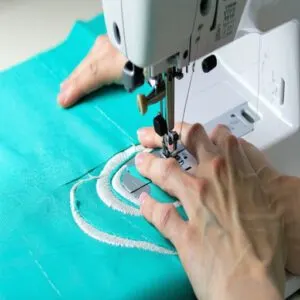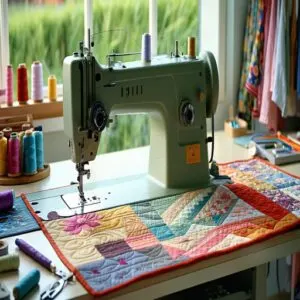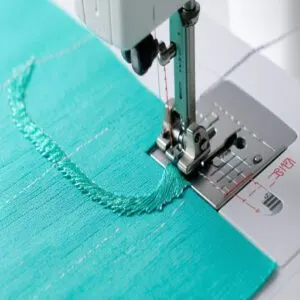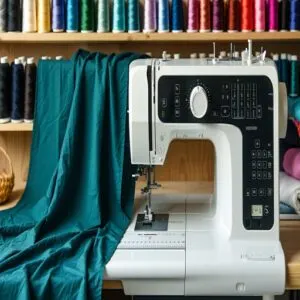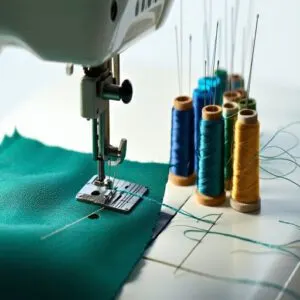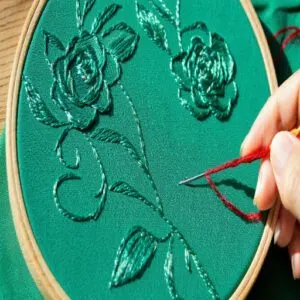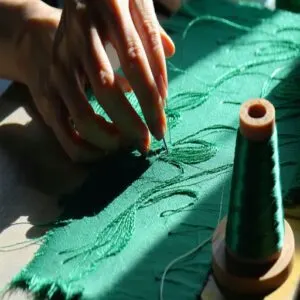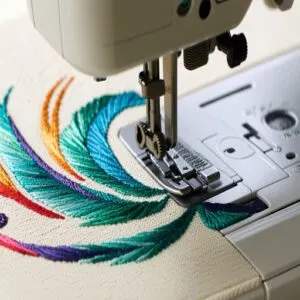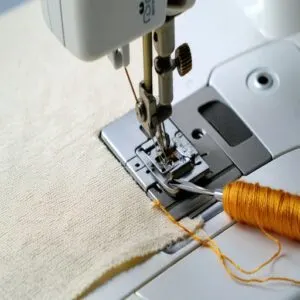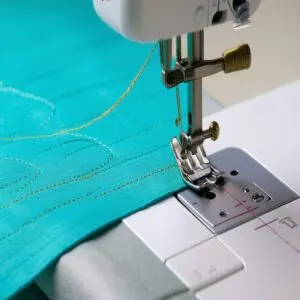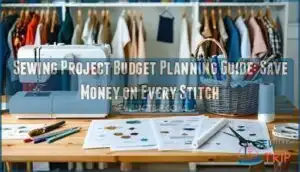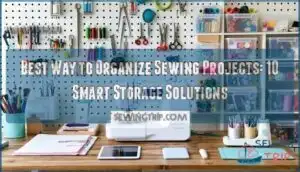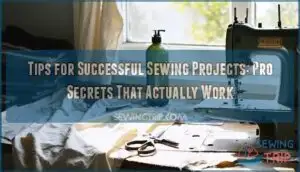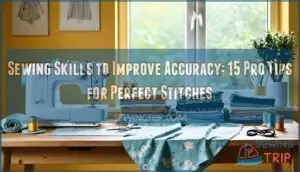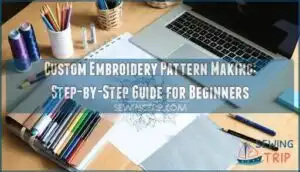This site is supported by our readers. We may earn a commission, at no cost to you, if you purchase through links.
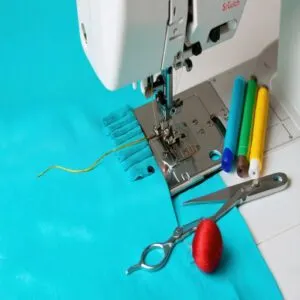 Free motion stitching gives you creative control over your sewing projects, letting you "draw" with thread and fabric.
Free motion stitching gives you creative control over your sewing projects, letting you "draw" with thread and fabric.
You’ll need a sewing machine that allows you to lower the feed dogs, a free motion foot, and sharp needles.
Stabilizers keep your fabric smooth, while fabric markers help outline your designs.
Don’t forget quilting gloves—they’re lifesavers for grip!
Start with basic shapes on scraps to build confidence.
Keep your machine clean, check the tension, and replace dull needles for smooth stitching.
Practice is key, but mistakes are part of the process—after all, perfection is overrated!
Ready to explore advanced techniques?
Table Of Contents
Key Takeaways
- Lower the feed dogs on your sewing machine, attach a free motion foot, and use stabilizers to keep your fabric smooth while stitching.
- Practice basic shapes on scrap fabric to control speed and movement, building confidence for more intricate designs.
- Use sharp needles, quality threads, and a clean, well-maintained machine to ensure smooth and even stitching.
- Grab essential tools like quilting gloves, embroidery hoops, and fabric markers to enhance precision and comfort during stitching.
Free Motion Stitching Basics
Free motion stitching lets you take full control of your sewing machine to create unique designs by moving the fabric in any direction.
To get started, you’ll need the right tools, a clean machine, and practice with simple shapes on scrap fabric, which will help you to achieve unique designs and master free motion stitching.
Essential Materials and Tools
To kick off your free motion stitching journey, stock up on fabric markers, stabilisers, and a trusty sewing machine with feed dog lowering.
Grab embroidery hoops for stability, quilting gloves for grip, and a Supreme Slider to keep fabric glide smooth.
A variety of free motion quilting gloves are available online.
Don’t skimp on quality needles and thread–they’re game-changers.
Machine Setup and Maintenance
Before stitching magic happens, your sewing machine setup matters.
Start with machine cleaning—clear lint from the bobbin case and feed dogs, and add oil maintenance per your manual, ensuring smooth movement.
Check sewing machine tension for balanced stitches, and swap dull needles for sharp machine embroidery needles.
Attach your presser foot and prep the bobbin.
Regular sewing machine maintenance keeps everything running like clockwork!
Free Motion Embroidery Techniques
Mastering free motion embroidery techniques starts with understanding stitch control and balancing fabric tension.
Play with embroidery effects and experiment with movement and speed.
Here’s how to sharpen your skills:
- Lower feed dogs for easy maneuverability.
- Practice simple free motion embroidery designs on scraps.
- Use a hoop for an even surface.
- Test thread blending with colors.
- Check machine calibration regularly.
Choosing Right Sewing Machine
Choosing the right sewing machine for free motion stitching starts with making sure yours has key features like adjustable feed dogs and a compatible free motion foot.
Look for a machine with a wide throat space and smooth speed control to give yourself the best results.
Domestic Sewing Machines
When exploring machine types for free motion quilting, domestic sewing machines are perfect for home use—affordable, versatile, and reliable.
They balance sewing speed, stitch quality, and motor power.
Use this guide to compare key features: For the best results, consider using a free motion quilting machine that suits your needs.
| Feature | Domestic Machines | Industrial Machines |
|---|---|---|
| Portability | Lightweight | Heavy, fixed setup |
| Cost | Affordable | Expensive |
| Motor Power | Moderate | High |
| Suitable For | Home projects | Commercial tasks |
Feed Dogs and Free Motion Foot
Lowering feed dogs isn’t always mandatory for free motion stitching, but it can help control fabric movement.
A good free motion presser foot—like a darning or open-toe option—lets you freely move fabric in any stitch direction.
Watch out for uneven foot pressure, which can cause drag.
Practice smooth movement to balance feed dog control and fabric flow.
Machine Requirements and Capabilities
A reliable sewing machine makes free motion stitching a breeze.
Look for these must-haves:
- Throat size: A larger space means easier fabric maneuvering.
- Feed dogs: Verify that they can be lowered or covered for complete control.
- Motor type: A strong motor keeps it steady during quilting.
- Tension control: Adjustable tension prevents uneven stitching nightmares.
For more detailed guidance, explore these best free motion quilting machines.
Add a free motion quilting foot for perfect results!
Selecting Needles and Threads
Choosing the right needle and thread is key to smooth and frustration-free stitching. Use a size 75/11 or 90/14 embroidery needle with quality 40-gauge rayon or polyester thread for the best results.
Embroidery Needles and Sizes
Understanding needles is key for smooth stitching.
Schmetz needles are popular, offering sizes based on thread weight for better stitch quality.
For 40 wt thread, try a size 75 needle.
For more detailed information, explore this guide on machine embroidery needles.
Check out this table for quick insight:
| Needle Size | Thread Weight | Use |
|---|---|---|
| 75/11 | 40 wt | Everyday stitching |
| 80/12 | 50 wt | Versatile projects |
| 90/14 | 30 wt | Thicker fabrics |
| 100/16 | 20 wt | Heavyweight threads |
Needle care matters—replace dull ones!
Proper Thread Tension and size guarantee top Embroidery Tips.
Thread Selection and Preparation
Choosing the right thread makes all the difference.
Opt for 40-wt polyester or rayon for smooth stitches.
Love detail? Try variegated threads for vibrant dimension.
For subtle designs, go with color matching; bold designs? Choose contrast.
Balance thread tension to prevent snags or thread breakage.
Experiment with fiber types and yarn textures for creative material blending in every stitch.
A wide variety of 40wt embroidery thread options are readily available online.
Needle and Thread Considerations
Pairing the right needle with your thread keeps stitches clean and frustration low.
Skipping this causes needle breakage or poor stitch quality. Use an embroidery needle sized for your fabric thickness and thread.
A helpful resource for choosing the correct needle is to explore embroidery needle size charts.
Watch thread tension and opt for smooth-threaded spools to avoid fabric fraying.
- Thin threads? Smaller needles.
- Bright thread colors? Test for bleeding.
- Threads snapping? Check tension.
Free Motion Embroidery Fabric
Choosing the right fabric for free motion embroidery is essential to achieving smooth, precise stitches.
Start with tightly woven, high-thread count cotton, as it’s easy to control and provides a stable surface for your designs.
Choosing Right Fabric Type
Don’t underestimate how your fabric choice shapes your project.
Lightweight cottons are ideal for beginners, while sturdy denim handles dense designs.
Pay attention to thread count, weave types, and texture options—each affects how stitches flow.
Testing fabric density guarantees smooth work.
Here’s a quick cheat sheet:
| Fabric Type | Weight | Weave | Texture | Best For |
|---|---|---|---|---|
| Cotton | Light | Tight | Smooth | Simple, detailed work |
| Denim | Heavy | Durable twill | Rough | Dense, bold designs |
| Silk | Light | Satin weave | Slippery | Elegant embroidery |
| Canvas | Thick | Basic weave | Textured | Large, sturdy designs |
| Linen | Medium | Looser weave | Crisp | Natural, rustic looks |
Fabric Weight and Texture
Fabric’s weight and texture do the heavy lifting in free motion embroidery.
Lighter fabrics need more stabilisers but glide smoothly, while heavier ones, like denim, stay put but require more effort.
- Smooth textures give clean lines.
- Rough surfaces add dimension.
- High-density weaves hold stitches better.
- Blended fabrics offer unique effects.
Experiment with fabric selection to uncover stunning results!
Preparing Fabric for Stitching
How do you make fabric ready for stitching success?
Start by ironing it smooth—creases can mess with stitch quality.
Next, match your stabilisers to the fabric type, like water-soluble for delicates or tear-away for rugged pieces.
Hoop the material firmly for fabric stabilization, ensuring even thread tension.
Careful fabric preparation prevents puckering and elevates your final design’s quality.
Mastering Free Motion Techniques
Mastering free motion techniques means practicing basic stitches like loops and waves while learning to control speed and direction.
Start with simple designs on scrap fabric to build confidence and improve your stitching skills.
Basic Stitches and Techniques
Think of free motion stitching like doodling, but with your sewing machine.
Start with basic stitches like loops or wavy lines.
Control your stitch length by balancing hand movement and speed management.
Experiment with stitch direction for curves or straight lines.
Adjust your fabric tension to avoid puckering, ensuring smooth thread visibility.
Practice on scraps to perfect your flow.
Thread Sketching and Painting
Think of thread sketching and painting like doodling with your sewing machine.
Use free motion stitching to "draw" bold outlines or fill shapes with texture, play with thread density for shading, experiment with stitch direction, and add fun color blending.
Combine fabric contrast with texture effects for depth.
Exploring free motion embroidery feels as freeing as creating with crayons!
Practice Tips and Troubleshooting
Start with scrap fabric to practice controlling speed and stitch tension.
Uneven stitching? Check your bobbin and thread path.
Thread breakage often signals tension issues or dull needles, so replace them if needed.
Fabric issues like puckering? Use stabilizers for support.
For consistent stitches, proper needle and thread compatibility is essential.
If machine errors arise, clean the bobbin case and feed dogs.
This free motion stitching guide stresses patience—progress improves precision!
Free Motion Stitching Essentials
You’ll need the right tools to make free motion stitching both fun and frustration-free.
From selecting a proper free motion foot to using handy accessories like quilting gloves and a Supreme Slider, these essentials set you up for smooth stitching success.
Free Motion Foot Selection
When picking a free motion foot, consider foot types like open toe for better stitch visibility or closed toe to avoid snags.
A darning foot or embroidery foot works well for beginners.
Check machine compatibility—most domestic machines use low shank feet.
Adjustable feet offer improved stitch control, while plastic feet enhance your view for intricate designs.
Quilting Tools and Accessories
Now that you’ve got your free motion foot sorted, it’s time to talk tools.
Having the right essential sewing machine accessories can substantially improve your free-motion quilting experience.
Quilting gloves keep your hands steady, while sewing tables with recessed platforms make fabric gliding a breeze.
Grab embroidery hoops for stability and fabric markers to sketch designs, add stencil guides for precision in free motion quilting, and don’t forget about lowering those feed dogs.
Frequently Asked Questions (FAQs)
Is free motion stitching a trouble-free process?
Free motion stitching isn’t completely trouble-free, but with the right setup and practice, it’s manageable.
Expect challenges like tension issues or uneven stitches, but they’re solvable.
A little patience and experimentation go a long way!
How to use a sewing machine for free motion embroidery?
Picture yourself drawing with thread—lower your feed dogs, attach a free-motion foot, and hoop your fabric with stabilizer.
Move the fabric freely under the needle while controlling speed.
Practice makes stitches smoother!
How do you free motion stitch?
Drop the feed dogs, attach a free-motion foot, and sketch with your needle like a pencil.
Control the fabric’s movement with your hands—practice loops, curves, and lines until your stitching feels natural and smooth.
How do I get Started with free motion embroidery?
Grab a machine with feed dog lowering, a free-motion foot, and stabilizers.
Practice on scrap fabric, sketch simple designs, and explore thread tension adjustments.
Confidence builds with experimentation—don’t stress about perfection.
What tools do I need for free motion embroidery?
Funny how the right tools make all the difference.
You’ll need a sewing machine (with feed dog lowering), a free-motion foot, embroidery thread, stabilizers, cotton fabric, quilting gloves, and maybe even a Supreme Slider.
How to free motion stitching?
Drop the feed dogs, attach a free-motion foot, and pick a sturdy fabric with stabilizers.
Move the fabric freely under the needle like you’re sketching.
Practice simple designs first—loops, waves, and lines.
How do you keep stitches even when free motion quilting?
Nearly 70% of quilters say uneven stitching is their top frustration.
To keep stitches even, control your speed: move your hands slower as the machine runs faster, practice consistent motion, and use a Supreme Slider.
What stitch should I use for free motion quilting?
Go with a straight stitch for free motion quilting.
Set the stitch length to zero, so movement’s all you.
It’s like doodling on fabric—play with speed and direction to make unique patterns pop!
What stitch length for free motion?
Set your stitch length to zero for free motion stitching.
Don’t worry—you’re controlling stitch size by your hand speed and machine pace.
Practice balancing both, and soon you’ll feel like an artist with fabric!
How do you clean and store finished embroidery?
Imagine spending hours on a design only to see it fade—yikes.
Gently wash with cold water, air dry flat, and store in acid-free tissue paper or a sealed plastic bag to protect it.
Conclusion
You’ve got everything you need to get started with free motion stitching—so don’t overthink it!
Experimentation is key, and mistakes? Those are threads of artistic brilliance in disguise.
Make sure your sewing machine’s ready, stock up on tools like a free motion foot and sharp needles, and start sketching those designs onto fabric.
With this free motion stitching guide, practice will transform your scraps into art.
Get stitching, and let your creativity take center stage!
- https://www.onthetrailcreations.com/free-motion-tutorial.html
- https://suzyquilts.com/free-motion-quilting-tutorial/
- https://www.gathered.how/sewing-and-quilting/sewing/how-to-thread-a-bobbin-essential-guide-for-beginners
- http://mailto:linda.uk
- https://freemotionproject.com/2011/05/to-drop-or-not-drop-that-is-question.html

